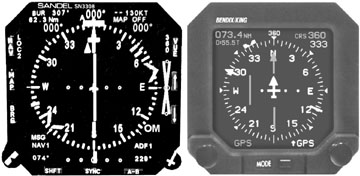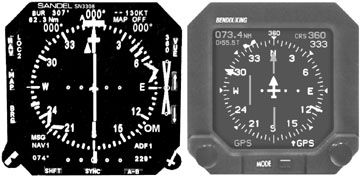
by Larry Anglisano
When Bendix/King introduced the EFIS40/50 Electronic Flight Instrument System two decades ago, the product was a hit with owners lusting over airplane and bizjet glass cockpits. The $80,000-plus EFIS became optional equipment in airplanes as small as Mooneys and Malibus, although precious few could afford it.
These days, the Bendix/King EFIS 40 and the 5-inch EFIS 50 live on in the likes of Pilatus PC12s and TBM700s. For the rest of us, EHSI options are limited to two decidedly downscale options: the Bendix/King KI825 and the now discontinued Sandel SN3308. The modern EHSI concept is simpler and cheaper than the original EFIS, as there’s no need for expensive remote symbol generators and related wiring. All you need is a remote heading gyro and a nav source, plus a magnetic flux detector for gyro slaving.
Sounds inexpensive, right? Not really. A seemingly simple concept involves more installation cost than most owners expect and with primary flight displays dominant, does it really make sense to replace an aging mechanical HSI with an EHSI? Possibly, but EHSIs were conceived before sophisticated multi-function displays became capable and affordable. In other words, reduce you expectations. Dont expect an EHSI to rival what your Garmin 430/540 or an Avidyne EX500 can add to overall panel capability.
Worth the Cost?
In our view, many owners buy into EHSI technology half-blind. By that, we mean our impression is that buyers often think EHSIs have greater capability than they do. But one doesnt-or shouldnt–buy an EHSI for superior gee-whiz graphics. If you compare any EHSI display to a basic MFD or even a portable navigator, there’s not much there. Heading and course information digitally as opposed to a mechanical needle format buys you little, in our view.
The overall appeal is the ability to overlay multiple nav sources and bearing pointers on one heading display. The simplification of the scan is clearly a benefit, especially since for lack of panel real estate, some airplanes have instruments and avionics scattered everywhere.
Auto-slewing of the active course for each segment of the flight plan provides help when hand flying and so does more automation when the autopilot is in control. In the Sandel, marker beacons and lightning strikes are incorporated into the display. The KI825 offers only the strikes.
Since the EHSI is a true heading display, the overlaid course, waypoint and map data will be in proper orientation to the aircraft heading, unlike the general map stabilization found on many MFDs. In theory, this means a more unified scan and better situational awareness. If youre of belt-and-suspenders mentality, using a secondary GPS system for crosscheck or to monitor multiple waypoints, an EHSI will allow you to see this waypoint data at a glance. On the other hand, weve seen pilots confused by too much data on one screen, which is an argument for keeping things simple with a single mechanical HSI.
Many owners seem to approach the EHSI concept with the notion that this display is all thats required. Not really. Since an EHSI shows the same data a mechanical HSI does, it needs to be fed heading, nav and course data. This requires the addition of remote units and some accessories, too.
The Sandel SN3308, the first EHSI of its kind, played primarily with the Bendix/King KG102A remote gyro, a widely available unit. When the Sandel craze caught on, Bendix/King found shops buying half of the full KCS55A HSI system, just the KG102A gyro and KMT112 magnetic flux detector, to drive the Sandel. Bendix/King responded with unfavorable a la carte pricing on the compass system, which prompted
Mid-Continent to boldly step in with an alternative: the RDG500, a remote electric gyro and a Humphrey flux system with similar design to the well-proven KG102A/KMT112, but cheaper.
Financially and technically, if you have a Bendix/King KCS55A mechanical HSI, youre in the best position to upgrade to an EHSI, with the ability to retain the mechanical KI525A as a secondary display. If there’s no existing compass system, however, the size of the retrofit and cost escalate considerably. There are multiple ways to make a given interface work, depending on the equipment the EHSI system is expected to talk to. With no remote compass available, the Bendix/King KI825, for instance, will cost $20,000 to $22,000 to install.
The Sandel SN3308 was introduced with lots of simple interface capability and it matured to accept more. But the market proved limited and Sandel has discontinued it. For some time, Sandel has been teasing buyers with a promised new EHSI equipped with a better display and improved functionality.Its late to market and we suspect that a lot of the companys efforts have been diverted to their ST3400 TAWS/RMI display. Sandel tells us that the replacement for the SN3308 EHSI will be launched at any time. Their Web site still gives the date as end of 2004.
We can think of some improvements. Most shops complain about the SN3308s connector and mounting scheme. Maintenance issues for this system make many techs wince with seating and mating problems leading the list of faults.These can be hard to fix reliably. Were told that Sandels follow-on product will have improved mounting and connector design, which we applaud. When it comes to installation hardware and overall maintenance capabilities, the Bendix/King KI825 is superior in our view, but hardly without problems.
Bendix/King KI825
With the discontinuation of the Sandel SN3308, the KI825 is the only game in town in new 4-inch electronic EHSIs. A used Sandel is a possibility and can be found on the used marked for about $8000, while a new KI825 retails for $12,370.
The KI825 could be considered trickle-down EFIS 40 technology and one look at its display reveals it to have a close family resemblance. It will display lightning data when connected with the WX-500 Stormscope and it plays with all common Honeywell remote gyros, including the KG102A and KSG105. Nav interfaces include the KLN94/KLN89 GPS series via analog RS232 interface and the KLN90/900 GPS navigators, as we’ll as the Garmin GN430/530 series through an ARINC 429 data stream.
As Richard Hardoon reports on his KI825 installation, communication problems between the unit and Garmin products remain unresolved, suggesting to us the manufacturers have limited commitment to this class of products.Further, although old school analog signals are generally reliable, some shops have told us that getting the KI825 to talk efficiently to other than Bendix/King autopilots has been a battle lost. The KI825 will operate on 14- or 28-volt DC power sources, making it a player in most applications.
What we like most about the KI825-aside from its professional look and feel-is its configuration and maintenance potential. The Sandel SN3308 lacks in the sense that all of the detail-intensive configuration data settings are unit specific, so if a loaner or replacement is installed, it will need to be configured from scratch to play as the old one did. Hopefully, the tech who removed it made good notes on the old settings.
The Sandel does, however, have the ability to dump configuration data into a computer for future upload but this can be awkward under time pressure.The KI825 has an optional configuration module that stores the data for unit swap outs. Like most of the Honeywell IHAS suite, this reflects big airplane mentality.
The viewing angle of the KI825 is better than the SN3308. We flew the KI825 in a new Grand Caravan (coupled with a GNS530 and GNS430) recently and found it readable from the copilots position, a good shot across the Caravans panel. Youd be hard pressed to see a Sandel SN3308 clearly from that angle.
Conclusion
Were not convinced that tossing a reliable mechanical HSI such as a Bendix/King KI525A or even a Century NSD360A makes economic and technical sense. Despite what Bendix/King claims, its not an easy plug-and-play even if you have the remote gyros already installed. If you have to have an EHSI and are KCS55A equipped, we suggest retaining the KI525A as a secondary and back-up indicator.
If you have no HSI at all, the KI825 will cost between $20,000 and $22,000 to install, variable by airplane. Bendix/King is currently offering trade-in value on existing KI525A systems against a new KI825, but were not sure this is a great idea. While its true the installation will be somewhat simplified because the KI525A will already be interfaced in the mix, the downside is that this by no means a simple installation affair. Some installations require only a few additional wires but this doesnt happen very often.
As the new Sandel unit comes to market, pricing on used older SN3308s will become attractive, but you’ll still need all the parts and pieces of the compass system and the installation headaches that go with it. In the world of do-it-all MFDs, EHSIs look less attractive than they once did.
Also With This Article
“Checklist”
“KI825: Crisp Display, Doesnt Always Play we’ll With Others”
“Sandel: Good Utility, Robust, Two Bulb Failures”
-Larry Anglisano is Aviation Consumers avionics editor. He works at Exxel Avionics in Hartford, Connecticut.


